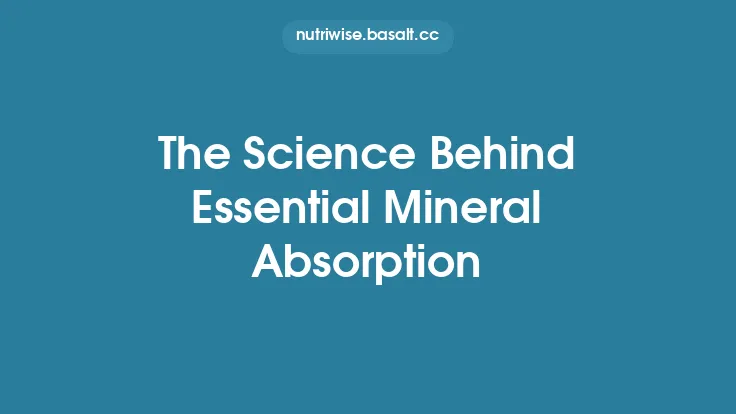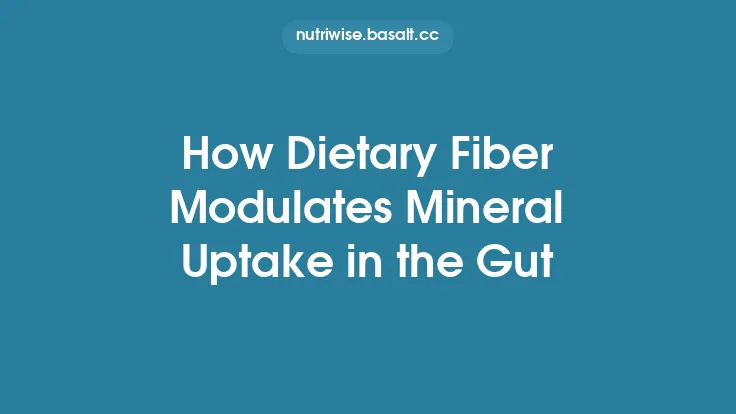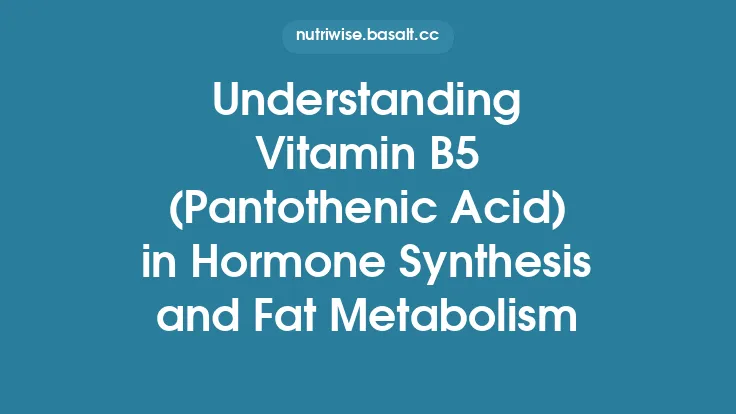Mineral homeostasis is the body’s finely tuned system for keeping essential inorganic elements—such as calcium, magnesium, potassium, sodium, phosphate, and trace metals—within narrow concentration ranges that are compatible with optimal physiological function. Unlike macronutrients, which can be stored in large quantities, many minerals are required in precise amounts; even modest deviations can disrupt enzymatic activity, electrical signaling, and structural integrity. The body therefore relies on a network of organs, hormones, transport proteins, and cellular sensors that continuously monitor and adjust mineral levels in real time. Understanding how this network operates provides a foundation for recognizing the early signs of dysregulation, interpreting laboratory data, and appreciating the body’s remarkable capacity for self‑regulation.
Overview of Mineral Homeostasis
At its core, mineral homeostasis is a dynamic equilibrium. The system must reconcile three competing demands:
- Supply – the influx of minerals from diet, endogenous recycling, and, for some trace elements, microbial synthesis.
- Distribution – the allocation of minerals to compartments where they are needed (e.g., extracellular fluid, intracellular cytosol, bone matrix, intracellular organelles).
- Excretion – the removal of excess or toxic amounts via the kidneys, gastrointestinal tract, sweat, and, for certain metals, the biliary system.
These processes are not independent; they are linked by feedback loops that sense concentration changes and trigger corrective actions. The equilibrium point—often called the “set point”—varies among minerals and is shaped by genetics, age, sex, and physiological state (e.g., pregnancy, illness).
Key Organs Involved in Regulation
| Organ | Primary Role in Mineral Homeostasis | Representative Mechanisms |
|---|---|---|
| Kidneys | Fine‑tune plasma concentrations by reabsorbing or secreting minerals in the nephron. | Sodium‑chloride cotransporters (NCC), Na⁺/K⁺‑ATPase, calcium‑sensing receptor (CaSR)‑mediated adjustments in the distal tubule. |
| Parathyroid Glands | Detect extracellular calcium and secrete parathyroid hormone (PTH) to raise calcium levels. | PTH stimulates renal calcium reabsorption, bone resorption, and activation of vitamin D. |
| Thyroid & Parathyroid (Calcitonin) | Lower plasma calcium when it rises above set point. | Calcitonin reduces osteoclast activity and promotes renal calcium excretion. |
| Liver | Stores and releases phosphate, copper, and iron; synthesizes carrier proteins (e.g., transferrin, ceruloplasmin). | Hepatic ferritin stores iron; liver releases phosphate during fasting. |
| Intestine | Absorbs minerals from the lumen; also a site of regulated excretion (e.g., fecal loss of excess copper). | Enterocytes express transporters (e.g., DMT1 for iron) that are modulated by systemic signals. |
| Bone | Acts as a reservoir for calcium, phosphate, magnesium, and trace metals. | Osteoblasts and osteoclasts remodel bone in response to hormonal cues, releasing or sequestering minerals. |
| Skin & Sweat Glands | Minor route for loss of sodium, potassium, and trace metals, especially during heat stress. | Sweat composition reflects plasma electrolyte status, providing a rapid, albeit small, excretory pathway. |
Hormonal and Molecular Controllers
Calcium‚ÄëSpecific Regulators
- Parathyroid Hormone (PTH): Increases renal calcium reabsorption, stimulates osteoclast-mediated bone resorption, and activates 1α‑hydroxylase in the kidney to produce calcitriol (active vitamin D), which enhances intestinal calcium absorption.
- Calcitonin: Secreted by thyroid C‚Äëcells; opposes PTH by inhibiting osteoclasts and promoting renal calcium excretion.
- Calcitriol (1,25‚Äë(OH)‚ÇÇD): Amplifies transcription of calcium‚Äëbinding proteins (e.g., calbindin) in the intestine and kidney, indirectly influencing plasma calcium.
Sodium‚ÄëPotassium Balance
- Aldosterone: Increases Na⁺ reabsorption and K⁺ secretion in the distal nephron via up‑regulation of ENaC (epithelial sodium channel) and ROMK (renal outer medullary potassium channel).
- Atrial Natriuretic Peptide (ANP): Counteracts aldosterone, promoting natriuresis (sodium excretion) and diuresis, thereby influencing extracellular fluid volume and potassium distribution.
Phosphate Homeostasis
- Fibroblast Growth Factor 23 (FGF‚Äë23): Secreted by osteocytes; reduces renal phosphate reabsorption by down‚Äëregulating NaPi‚ÄëIIa/IIc cotransporters and suppresses calcitriol synthesis.
- Klotho: Co‚Äëreceptor for FGF‚Äë23; its expression in the kidney is essential for phosphate handling.
Trace Metal Regulation
- Hepcidin: Central regulator of iron; binds ferroportin on enterocytes and macrophages, causing its internalization and reducing iron export.
- Metallothioneins: Low‚Äëmolecular‚Äëweight proteins that bind zinc, copper, and cadmium, buffering intracellular concentrations and protecting against oxidative stress.
Cellular Mechanisms of Mineral Balance
Within each cell, mineral concentrations are tightly controlled by a suite of transporters, channels, and buffering proteins:
- Ion Channels: Voltage‚Äëgated and ligand‚Äëgated channels (e.g., L‚Äëtype calcium channels, potassium rectifiers) permit rapid fluxes that underlie excitability and signaling.
- Transporters: Active transporters (e.g., Na⁺/K⁺‑ATPase) maintain electrochemical gradients essential for secondary active transport of other minerals.
- Intracellular Buffers: Proteins such as calmodulin (calcium) and metallothionein (zinc, copper) sequester free ions, preventing cytotoxic spikes.
- Organelle Sequestration: Mitochondria and the endoplasmic reticulum serve as reservoirs for calcium, modulating cytosolic levels during signaling events.
Cellular sensors—often conformationally sensitive to ion concentrations—trigger downstream signaling cascades. For example, the calcium‑sensing receptor (CaSR) on parathyroid cells detects extracellular calcium and modulates PTH secretion accordingly.
Homeostatic Set Points and Feedback Loops
The body’s “set point” for each mineral is not a static value but a range that can shift in response to chronic stimuli:
- Short‚ÄëTerm Feedback: Rapid adjustments (seconds to minutes) via neural reflexes (e.g., baroreceptor‚Äëmediated changes in renal sympathetic tone) and hormone release (e.g., PTH surge after a sudden drop in calcium).
- Long‑Term Feedback: Slower adaptations (hours to days) involving changes in gene expression (e.g., up‑regulation of Na⁺ transporters in response to chronic low sodium intake) and remodeling of storage compartments (e.g., bone turnover affecting calcium and phosphate reserves).
Mathematically, these loops can be modeled using control theory, where the “error signal” (difference between measured concentration and set point) drives corrective actions proportional to the magnitude of the deviation (proportional control) and, in some cases, integrated over time (integral control) to eliminate steady‑state errors.
Pathophysiology of Dysregulated Homeostasis
When any component of the regulatory network fails, characteristic clinical syndromes emerge:
| Mineral | Common Dysregulation | Typical Clinical Manifestations |
|---|---|---|
| Calcium | Hyperparathyroidism, hypoparathyroidism, vitamin‚ÄØD deficiency | Tetany, nephrolithiasis, bone demineralization, cardiac arrhythmias |
| Sodium | Syndrome of inappropriate antidiuretic hormone (SIADH), adrenal insufficiency | Hyponatremia ‚Üí cerebral edema; hypernatremia ‚Üí cellular dehydration |
| Potassium | Aldosterone excess/deficiency, renal tubular disorders | Hyperkalemia ‚Üí muscle weakness, arrhythmias; hypokalemia ‚Üí cramps, paralysis |
| Phosphate | Chronic kidney disease (CKD) ‚Üí hyperphosphatemia; FGF‚Äë23 excess | Vascular calcification, secondary hyperparathyroidism |
| Iron | Hemochromatosis, anemia of chronic disease | Organ iron overload, fatigue, impaired immunity |
| Zinc | Malabsorption, chronic liver disease | Dermatitis, impaired wound healing, immune dysfunction |
| Copper | Wilson disease, Menkes disease | Neurologic decline, hepatic dysfunction, connective tissue abnormalities |
Understanding the underlying feedback failures—whether hormonal insensitivity, transporter mutation, or organ dysfunction—guides targeted therapeutic interventions.
Diagnostic Approaches to Assess Homeostasis
A comprehensive evaluation of mineral balance integrates laboratory, imaging, and functional tests:
- Serum Electrolyte Panel: Provides immediate snapshot of Na⁺, K⁺, Cl⁻, Ca²⁺, Mg²⁺, and phosphate.
- Hormone Assays: PTH, calcitriol, aldosterone, renin activity, FGF‑23, hepcidin—help pinpoint regulatory disturbances.
- Urinary Excretion Studies: 24‚Äëhour collections for calcium, magnesium, phosphate, and creatinine clearance assess renal handling.
- Fractional Excretion Calculations: Quantify the proportion of filtered load that is excreted, revealing tubular reabsorption defects.
- Imaging: DEXA scans for bone mineral density; MRI for iron overload (e.g., T2* imaging in the liver and heart).
- Genetic Testing: Identifies mutations in transporters (e.g., SLC12A3 in Gitelman syndrome) or regulatory proteins (e.g., HFE in hemochromatosis).
Interpreting these data requires an appreciation of the interplay among compartments; for instance, a low serum calcium with elevated PTH suggests a compensatory response, whereas low calcium with low PTH may indicate hypoparathyroidism.
Age‚ÄëRelated and Physiological Variations
- Neonates & Infants: Immature renal concentrating ability makes them vulnerable to sodium and potassium fluctuations; rapid bone growth demands high calcium and phosphate turnover.
- Adolescents: Pubertal growth spurts increase calcium and magnesium requirements; hormonal surges (growth hormone, sex steroids) modulate bone remodeling.
- Adults: Homeostatic mechanisms are generally robust, but lifestyle factors (e.g., high sodium intake, chronic stress) can subtly shift set points.
- Elderly: Declining renal function reduces the capacity to excrete excess potassium and phosphate; bone resorption outpaces formation, altering calcium/phosphate dynamics.
- Pregnancy & Lactation: Placental transport and milk production create unique mineral fluxes; for example, fetal calcium demand is met by increased maternal intestinal absorption and bone mobilization, regulated by elevated calcitriol and PTH‚Äërelated peptide (PTHrP).
Interactions Among Minerals in Homeostatic Networks
Minerals rarely act in isolation; their regulatory pathways intersect:
- Calcium–Phosphate Coupling: PTH and calcitriol simultaneously raise calcium while lowering phosphate reabsorption; FGF‑23 does the opposite, illustrating a push‑pull balance.
- Sodium–Potassium Antagonism: The Na⁺/K⁺‑ATPase creates a reciprocal relationship; changes in extracellular sodium can influence intracellular potassium and vice versa.
- Magnesium–Calcium Interplay: Magnesium is a cofactor for the PTH receptor; hypomagnesemia can blunt PTH secretion, leading to secondary hypocalcemia.
- Zinc–Copper Competition: Both share the same intestinal transporters (e.g., ZIP4, CTR1); excess of one can impair absorption of the other, indirectly affecting systemic homeostasis.
Recognizing these cross‚Äëtalks is essential when interpreting laboratory abnormalities, as a primary defect in one mineral may manifest as secondary changes in another.
Emerging Research and Future Directions
- Precision Homeostasis: Leveraging wearable sensors that continuously monitor extracellular electrolyte concentrations (e.g., sweat‑based Na⁺/K⁺ sensors) could enable real‑time feedback loops akin to artificial pancreas systems for glucose.
- Genomic Editing: CRISPR‚Äëbased correction of transporter mutations (e.g., SLC12A3 in Gitelman syndrome) is under investigation, promising disease‚Äëmodifying therapies.
- Microbiome‚ÄëMineral Axis: Recent studies suggest gut microbial metabolites influence systemic magnesium and iron handling, opening avenues for probiotic modulation of mineral homeostasis.
- Nanoparticle Chelators: Targeted delivery of metal‚Äëbinding nanoparticles aims to sequester excess iron or copper in conditions like hemochromatosis without systemic depletion.
- Systems Biology Modeling: Integrative computational models that incorporate hormonal kinetics, renal transport dynamics, and bone turnover are being refined to predict individual responses to interventions (e.g., diuretics, phosphate binders).
These advances underscore a shift from reactive correction of overt imbalances toward proactive maintenance of the internal mineral milieu.
Practical Takeaways for Maintaining Homeostasis
- Hydration & Renal Health: Adequate fluid intake supports optimal glomerular filtration, enabling the kidneys to fine‚Äëtune electrolyte excretion.
- Stress Management: Chronic activation of the sympathetic nervous system can elevate aldosterone and renin, subtly shifting sodium and potassium balance.
- Regular Monitoring: For individuals with known renal, endocrine, or genetic disorders, periodic assessment of serum and urinary mineral parameters helps catch early deviations.
- Medication Review: Certain drugs (e.g., loop diuretics, ACE inhibitors, proton‚Äëpump inhibitors) influence mineral handling; clinicians should consider their impact on homeostatic set points.
- Lifestyle Adjustments: Moderate physical activity promotes efficient sweat‚Äëmediated electrolyte turnover, while avoiding extreme heat exposure reduces the risk of abrupt sodium loss.
By appreciating the body’s intrinsic regulatory architecture, clinicians, researchers, and health‑conscious individuals can better recognize when the system is operating within its optimal window and intervene judiciously when it strays. The elegance of mineral homeostasis lies in its constant, silent vigilance—maintaining the delicate chemical balance that underpins every heartbeat, nerve impulse, and bone‑building process.





